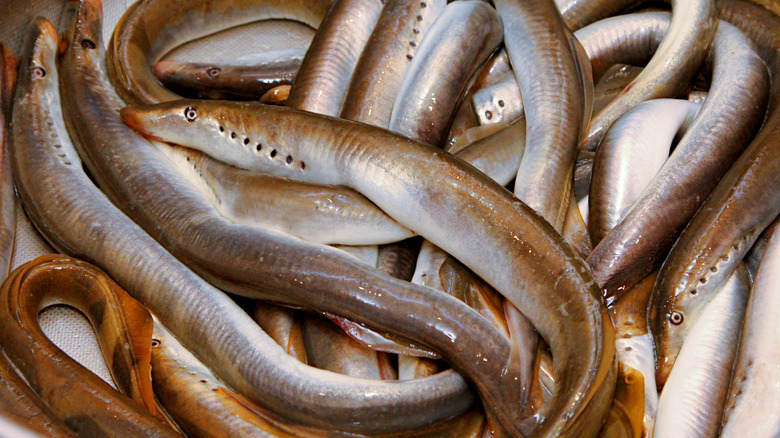The English King Who Supposedly Died From Eating Too Many Eels
Being a member of Britain's royal family comes with its fair share of perks, including a direct line of communication with a full kitchen staff whose job is to cater to your every craving. Monarchs have taken full advantage of this privilege for hundreds of years, for better or for worse. Their food preferences, which range from predictably decadent to downright shocking, have long fascinated the public.
Former royal chef Darren McGrady told Us Weekly that the late Queen Elizabeth II loathed pizza, as well as sandwiches served "with points," (per Real Royalty). McGrady told Hello Magazine that Her Majesty preferred rounded jam penny sandwiches (fancy Uncrustables) and Gleneagles pâté made from smoked salmon, trout, and mackerel from the Balmoral Estate.
Henry VIII is said to have occasionally dined on roasted swan, which was served as a centerpiece with a crown atop its lifeless head (per South China Morning Post). Decades before, legend has it that Henry VIII's predecessor Henry I preferred to fill up on an eel-like fish. Sadly, that which brought him joy may have also been the cause of his untimely death.
A sufeit of lampreys
In "Henry I: King of England and Duke of Normandy," biographer Judith A. Greene writes that William the Conqueror's youngest son, Henry I, is rumored to have met his fate after eating one too many parasitic fish at his hunting lodge in Normandy's Lyons-la-Foret. While the monarch was said to be in "sufficiently good health" at the start of the trip, he fell ill soon after his aquatic feast and died a few days later. As such, one of the King's most prominent biographers, Henry of Huntingdon, attributed His Majesty's death to "a surfeit of lampreys."
The predator, which is often confused with an eel due to its long, boneless shape, is one of the oldest vertebrate species in the ocean, according to National Ocean Service. It's distinguished by its unique mouth, which resembles a suction cup and is "ringed with sharp, horny teeth, with which it latches on to an unfortunate fish." Those fish can even include whales and dolphins. Evidently, the lamprey that allegedly caused the King's death had yet to fill its prey quota. Upon news of King Henry's death, the Royal Family website writes that his nephew, Stephen of Blois, took his place and "had himself crowned at Westminster within the month."
According to Mirror UK, modern historians are pretty sure food poisoning was a more likely cause of Henry I's death. Still, lampreys were almost certainly the star of his final meal.
Lamprey stans prevail
Against all odds, Henry I's lamprey-related death has not deterred modern gastronomes from consuming the scary-looking predator. In 2012, Queen Elizabeth II was gifted a lamprey pie for her Diamond Jubilee, but would not meet her fate for another 10 years.
In 2015, Vice's Ewout Lowie sat down with some Dutch members of the Sea Lamprey Society, founded by the artist and food archeologist Henri Roquas (a popular first name among lamprey lovers, apparently), as they were preparing a dinner of the fanged creatures sourced from the French Aquitaine; the waters that played host to the accidental murderer of Henry I.
Above all else, the Society reveres the carnivore for its impressive endurance in the watery food chain. Roquas calls the species an "immortelle," or a "living fossil." As its fellow sea creatures have evolved into fish, the lamprey has remained in its original form for over 500 million years, having originated before dinosaurs walked the earth. "The notion that the smell and flavor that I experienced were exactly the same for the very first people that roamed the earth and ate sea lamprey somehow had a direct effect on my mood," writes Lowie.


